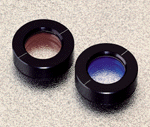|
Principle of Waveplate
Waveplates (retardation plates or phase shifters) are made from materials which exhibit birefringence. The velocities of the extraordinary and ordinary rays through the birefringent materials vary inversely with their refractive indices. The difference in velocities gives rise to a phase difference when the two beams recombine. In the case of an incident linearly polarized beam this is given by a = 2p * d(ne-no)/l (a - phase difference; d - thickness of waveplate; ne, no - refractive indices of extraordinary and ordinary rays respectively; l-wavelength). At any specific wavelength the phase difference is governed by the thickness of the retarder.
|
 |
|
Half Waveplate
The thickness of a half waveplate is such that the phase difference is 1/2-wavelength (l/2, true-zero order) or certain multiple of 1/2-wavelength [(2n+1)/l/2, multiple order].
A linearly polarized beam incident on a half waveplate emerges as a linearly polarized beam but rotates such that its angle to the optical axis is twice that of the incident beam. Therefore, half waveplates can be used as continuously adjustable polarization rotators. Half waveplates are used in rotating the plane of polarization, electro-optic modulation and as a variable ratio beamsplitter when used in conjunction with a polarization cube.
|
 |
|
l/4 Half Waveplate
The thickness of a half waveplate is such that the phase difference is 1/4-wavelength (l/4, true-zero order) or certain multiple of 1/4-wavelength [(2n+1)/l/4, multiple order].
A linearly polarized beam incident on a half waveplate emerges as a linearly polarized beam but rotates such that its angle to the optical axis is twice that of the incident beam. Therefore, half waveplates can be used as continuously adjustable polarization rotators. Half waveplates are used in rotating the plane of polarization, electro-optic modulation and as a variable ratio beamsplitter when used in conjunction with a polarization cube.
|

|
|